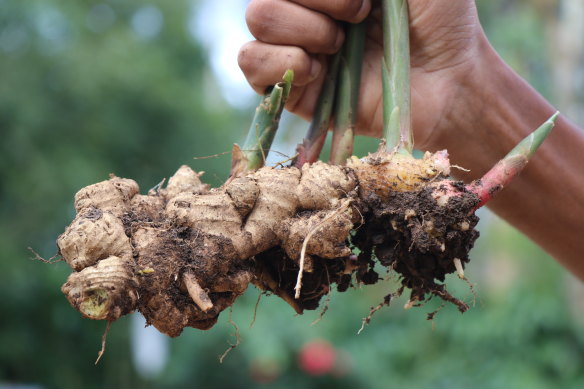
But if it’s Australian edibles you’re leaning towards, Mindy Woods details everything from saltbush and callistemon to banksia and Geraldton wax in her new book Karkalla at Home: Native foods & everyday recipes for connecting to country.
You won’t find many of the native trees, shrubs and climbers she discusses in the productive section of your local nursery but Woods, who has a much-lauded restaurant in Byron Bay, gives recipes (think paperbark ice cream, lemon myrtle mayo and wattleseed espresso martini) showing how well they lend themselves to the kitchen.

Ginger and turmeric are relatively easy to grow.Credit: iStock
In the garden, many of the plants she talks about can be grown year-round without expressly designed “edible beds”.
And when it comes to edible beds, there is no one-size-fits-all approach anyway. The trick is to find what works for your space and the sort of food you want to grow. As with all aspects of gardening, looking at what other people do is a rich source of ideas.
You will see formal edible beds edged in Dutch box, seasonal vegetables in raised timber planters and potted herbs deliberately positioned near kitchens in the Hawthorn gardens open for this year’s National Gallery of Victoria Women’s Association (NGVWA) Garden Day, which takes place on Thursday, October 24.
Loading
You can also look at how native edibles are being grown on an Indigenous rooftop farm above Sydney’s South Eveleigh precinct, which is open to the public from 12pm to 2pm weekdays.
And for the most accessible inspiration of all, always keep your eyes peeled for the front gardens, street gardens and community gardens you pass. Invariably you will glean new information.
Not everything you see will work for your space and your climate. Your garden might be too exposed for citrus, too cool for bananas or too boggy for olives, for example. Whatever your weak spots, best not to persist but to instead embrace what will readily thrive and provide abundant yields.
And as for plants that are bolting to seed as the weather warms, embrace that too. As Cao writes: “Letting your plants flower at this time of year helps to attract pollinators ... in turn, the pollinators help you by pollinating your veggies.”
But don’t get complacent. While seedlings of tomatoes, capsicums, eggplants and other cold-sensitive crops will never do as well if they are transplanted into the garden too early, leave it too late and you will only delay yields.
If you want summer produce, get moving now.
Make the most of your health, relationships, fitness and nutrition with our Live Well newsletter. Get it in your inbox every Monday.




























